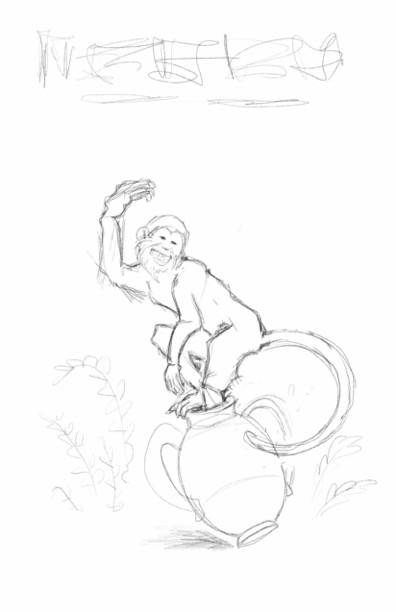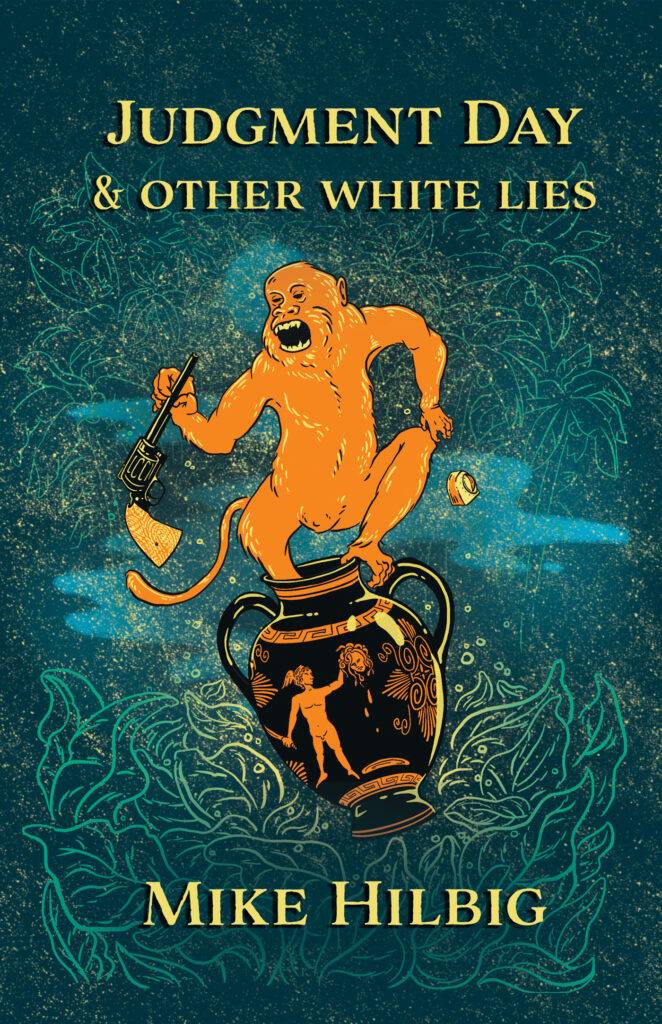Under the cover of Judgment Day & Other White Lies
guest post by Mike Hilbig
Shortly after my short story collection Judgment Day & Other White Lies was picked up by Madville Publishing, I read “Under the Cover – Mistakes by the Lake” on Madville’s blog where author Brian Petkash describes his process of coming to the stunning book cover design for his debut short story collection Mistakes by the Lake, a collection that is coincidentally my favorite book I’ve read from the Madville catalog. Since my own short story collection is, like Petkash’s, a linked collection with several shared themes, I reached out to Kim Davis, press director for Madville, and asked if it would be possible to have a local artist and graphic designer I knew design the cover for me.
Kim informed me, in fact, that it is the intention of Madville to offer author’s more creative control in the publication process, that she believes collaboration makes for better titles. Especially on an element like the cover design, she thinks writers can offer much help in selecting pointed images that direct readers’ eyes to books they will enjoy reading.
Collaborating with Crowcrumbs
In my own case, I knew right away I wanted to ask Crowcrumbs to design the cover. She is an old friend of mine and local artist in Houston, TX who studied design at the University of Houston and does compelling illustrations and graphic design. I also have always sensed a lot of similarity between her work and my own in terms of its thematic nature. In particular, two images spoke to me and told me she would be the best person to ask.
You see, my collection is centered around retellings of Greco-Roman and Christian myths that challenge foundational truths in American society like patriarchy, capitalism, and in particular, white supremacy. The above images jumped off the page to me as ones that were both blasphemous and reverent at the same time, images that could reflect my own technique of using meta-narratives that both reify and problematize traditional culture. Additionally, two of the more prominent stories in the collection in terms of their imagery are the opening alternative telling of Genesis “Para(Fa)ble of the Stoned Ape,” where violent sex-crazed stoned monkeys create western civilization by hallucinating and then telling stories of their hallucinations, and also, “‘Per-C and ‘Dusa: A Narrative Representation of a Graphic Epic’ by Angela Ames, PhD,” which is an ekphrastic retelling of the Perseus and Medusa myth in the form of a fake scholarly article. Therefore, the monkey and the mysterious woman adorned in religious imagery felt like they could be synthesized in some form that would make for a great cover to Judgment Day & Other White Lies.
Not to mention, most of the collection takes place in Houston, TX, where Crowcrumbs and I both live. In fact, one of Crowcrumbs’ most sought after images is her sketch of the famous rock music club Fitzgerald’s (RIP) which was once home to many of our favorite local punk bands over the years (buy a print of the below image here!). I figured between the ominous religious imagery, the evolutionary and creationist themes, and her photorealistic interpretations of local landmarks that we would surely find a cover design that was perfect for the book (and I believe the one we eventually came to is, in fact, perfect).

Setting out with a few images I picked out of Crowcrumbs’ catalog to give her direction on what kind of design I would like, we discussed the possibility of synthesizing local haunts, religious imagery, and also some imagery from the stories themselves. We also discussed doing a black-and-white color scheme that would align with the discussions on racial identity that are interspersed throughout the collection. Crowcrumbs went to work sketching some rough images that we might use on the cover.




She also told me she liked the process because while “it relates to the text, it is also not necessarily true to life, something that makes it both an interpretation and its own creation, and I get to use my other skills at my day job too where I focus on user experience of software design. It forces me to consider the audience and what they will imagine as they read the words and process my artwork.”


“I just didn’t think the black-and-white version,” Crowcrumbs explained, “or the later version I made, where the monkey was a traditional brown, were fully hitting on the surrealism I encountered in the book. Your stories pop off the page by flaunting expectations, and I wanted a color scheme that did the same. This was why I went with a traditional orange for the vase and used it on the monkey too while using the more surreal greens and blues and starry sky elements in the background.”
I was thrilled with it when she sent me the initial proof and believed this was where she really came through in taking ownership of the image, as I told her she had free rein to do, since she was the artist and I was the writer. I trusted her skill and trusted her as a person, us being friends for years and all (and in the same online book club together to protect our sanity during the pandemic).
I just love how the image is both threatening and playful, evocative in the color scheme, and how with the presence of Greek history, a revolver, an egg timer, and a wild monkey, that it creates a true sense of urgency, along with mystery, something that I hope this collection does in terms of engaging white people in their own interest in dismantling white supremacy.
So that’s the story of how the book cover came into being. If you like the cover design, please consider commissioning Crowcrumbs for your own artistic needs. Again, this cover perfectly captures my literary aesthetic in a visual form. Also, you can purchase copies of her prints, as well as t-shirts and stickers with her artwork on it here. Lastly, for those of you local to Texas, be on the lookout for combined readings and art show collabs between Crowcrumbs and me to promote the book release, and to promote Crowcrumbs as the incredible artist and designer that she is.












